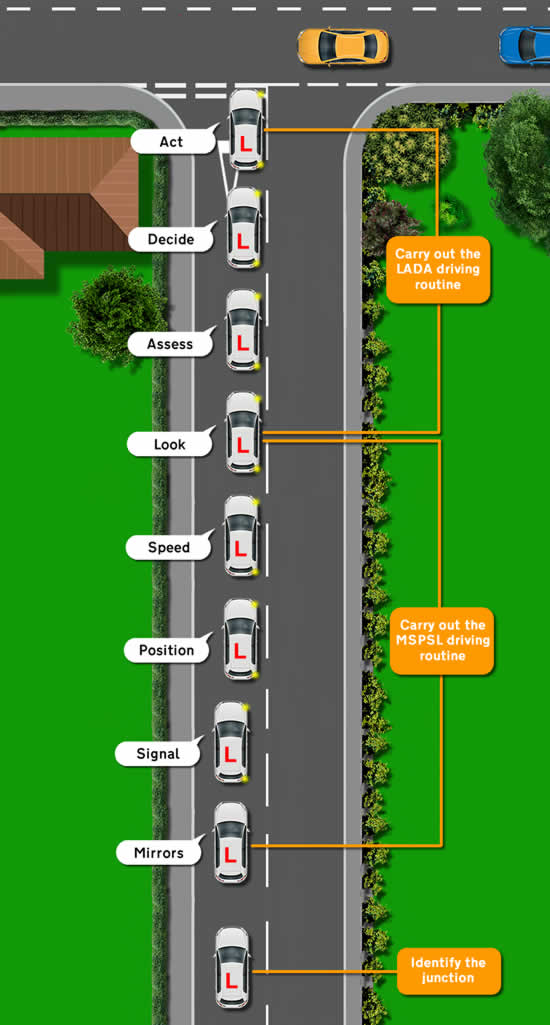In this tutorial we explain how to make a right turn at a T-junction in an automatic car. During a practical driving test, when providing directions, the examiner will typically refer to the approach of a T-junction as ‘the end of the road’. For example, ”At the end of the road, turn right”.
Identify the T-junction
When we ‘identify the junction’, we are doing two things; first is to locate how far away it is in order to conduct the MSPSL routine at an appropriate distance and secondly, it’s to identify the type of T-junction that we’re approaching. We need to identify if the T-junction is:
- Open
- Closed
- Marked (give way or stop junction? See T-junction road markings)
- Unmarked
- Controlled (are there advanced stop lines?)

Begin the MSPSL Driving Routine
The MSPSL driving routine stands for ‘Mirrors, Signal, Position, Speed and Look’. It’s a routine that’s taught by most driving instructors and should be used throughout learning to drive and during the practical driving test.
Mirrors
Whilst driving, we should always maintain awareness of what’s around us. For safety reasons, this is particularly important that we check our vehicle’s mirrors before changing speed or direction. As we’re turning right at the T-junction, we need to check the interior mirror, followed by the right door mirror.
Signal
We also need to let other road users and pedestrians what our intentions are. To do this, we signal to the right.
Position
We now need to prepare ourselves for turning right at the T-junction. Position the car just to the left of the centre line and maintain this position up to the junction line.
Speed
Speed relates to what you can or cannot see and extends from identifying the junction as described from the beginning. If the T-junction is ‘closed’ or a blind junction, it means you cannot see much, if anything at all of what’s going on in the major road that you intend on joining. If the junction is ‘open’ then you can clearly see if there’s traffic approaching on the major road and any other potential hazards.
As you approach, cover the brake and if the T-junction appears to be closed, gently apply pressure on the brakes to reduce speed. For a closed junction, you’ll need to slowly and smoothly (see how to brake smoothly in an automatic car) reduce your speed to around 5 mph or less, allowing you plenty of time to react to hazards and to stop at the junction line.
The benefit of driving an automatic car means that we do not need to manually change down gears. The car will naturally slow down when we cover the brake by what’s called ‘engine braking‘. If engine braking does not slow down the car enough, apply gentle pressure on the brake pedal.
Look
We now begin the last part of the MSPSL routine; ‘look’. It’s also the start of the LADA routine. At this stage, we should have identified the type of junction that we’re approaching, whether it’s open or closed and approaching at an appropriate speed. An appropriate speed allows us time to conduct effective observations. We need to be looking at 3 things;
- Up and down the major road we intend on joining
- Potential or actual hazards
- Where we are going
There’s often a lot going on at junctions, which means there’s a lot to look at. As you approach, continue to alternative your observation from left to right, up and down the road you intend on joining. You also need to be looking out for hazards such as pedestrians waiting, or about to cross the road at the junction in front of you.
If a pedestrian is waiting to cross and if it’s safe to do so, stop your vehicle and allow them to cross the road. Do not gesture them across as this can cause them to react without them first checking if it’s safe. For further information, see pedestrians crossing at junctions.
Along with all the other observations, you also need to remember to look where you’re going so that if you do stop (very likely when turning right), you need to ensure the front of your car has not entered the major road as you bring the vehicle to a standstill.
Assess
Everything that we were looking at, we now put together and assess. We need to evaluate the traffic on the major road, along with the potential hazards and make a decision.
Decide
Because we’re almost at the junction line, we now make a decision. It’s important that we are not indecisive as this can lead to mistakes.
Act
The final part of the LADA routine is ‘act’. This is where everything comes together; identifying the junction, the appropriate speed and the observations. In order to take the proper action at a T-junction, it’s important that all components are done correctly. At T-junctions, driving tests are often failed due to the candidate going too fast, a lack of effective observation, or a combination of both.
As you arrive at the junction line, maintain your position of just left of the centre line and if you stop, ensure that you do not stop so that the front of your vehicle is in the major road. For further information, see do you always have to stop at a T-junction?